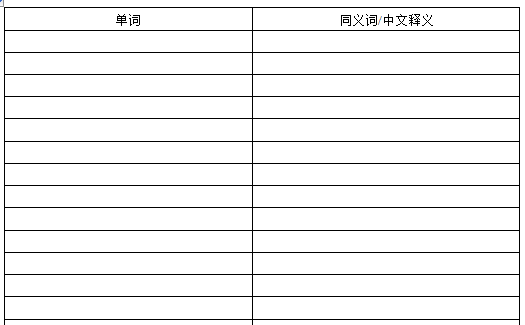摘要:新托福阅读能力是考试主办方重点考察的方向之一。除了在托福阅读部分考察外,在其他单项中也会出题考察。因此这需要考生们学习更多实用技巧来应对考试的挑战,大家在平时一定要多加练习,在下文中小编整理了托福阅读常考话题:地下水及练习题,一起来看看吧!
Passage 4
Groundwater
Most of the world’s potable water----freshwater suitable for drinking----is accounted for by groundwater, which is stored in the pores and fractures in rocks. There is more than 50 times as much freshwater stored underground than in all the freshwater rivers and lakes at the surface. Nearly 50 percent of all groundwater is stored in the upper 1,000 meters of Earth. At greater depths within Earth, the pressure of the overlying rock causes pores and cracks to close, reducing the space that pore water can occupy, and almost complete closure occurs at a depth of about 10 kilometers. The greatest water storage, therefore, lies near the surface.
Aquifers, Porosity and Permeability. Groundwater is stored in a variety of rock types. A groundwater reservoir from which water can be extracted is called an aquifer. We can effectively think of an aquifer as a deposit of water. Extraction of water depends on two properties of the aquifer: porosity and permeability. Between sediment grains are spaces that can be filled with water. This pore space is known as porosity and is expressed as a percentage of the total rock volume. Porosity is important for water-storage capacity, but for water to flow through rocks, the pore spaces must be connected. The ability of water, or other fluids, to flow through the interconnected pore spaces in rocks is termed permeability. In the intergranular spaces of rocks, however, fluid must flow around and between grains in a tortuous path; this winding path causes a resistance to flow. The rate at which the flowing water overcomes this resistance is related to the permeability of rock.
Sediment sorting and compaction influence permeability and porosity. The more poorly sorted or the more tightly compacted a sediment is ,the lower its porosity and permeability. Sedimentary rocks----the most common rock type near the surface----are also the most common reservoirs for water because they contain the most space that can be filled with water. Sandstones generally make good aquifers, while finer-grained mudstones are typically impermeable. Impermeable rocks are referred to as aquicludes. Igneous and metamorphic rocks are more compact, commonly crystalline, and rarely contain spaces between grains. However, even igneous and metamorphic rocks may act as groundwater reservoirs if extensive fracturing occurs in such rocks and if the fracture system is interconnected.
The water table is the underground boundary below which all the cracks and pores are filled with water. In some cases, the water table reaches Earth’s surface, where it is expressed as rivers, lakes and marshes. Typically, though, the water table may be tens or hundreds of meters below the surface. The water table is not flat but usually follows the contours of the topography. Above the water table is the vadose zone, through which rainwater percolates. Water in the vadose zone drains down to the water table, leaving behind a thin coating of water on mineral grains. The vadose zone supplies plant roots near the surface with water.
Because the surface of the water table is not flat but instead rises and falls with topography, groundwater is affected by gravity in the same fashion as surface water. Groundwater flows downhill to topographic lows. If the water table intersect the land surface, groundwater will flow out onto the surface at springs, weather to be collected there or to subsequently flow farther along a drainage. Groundwater commonly collects in stream drainages but may remain entirely beneath the surface of dry stream-beds in arid regions. In particularly wet years, short stretches of an otherwise dry stream-bed may have flowing water because the water table rises to intersect the land surface.
【段落主旨】
Paragraph 1:
Paragraph 2:
Paragraph 3:
Paragraph 4:
Paragraph 5:
【生词摘录】

免费领取最新剑桥雅思、TPO、SAT真题、百人留学备考群,名师答疑,助教监督,分享最新资讯,领取独家资料。
方法1:扫码添加新航道老师

微信号:shnc_2018
方法2:留下表单信息,老师会及时与您联系
| 课程名称 | 班级人数 | 课时 | 学费 | 报名 |
|---|---|---|---|---|
| 托福入门段(A段)6-10人走读班 | 6-10人 | 80课时 | ¥15800 | 在线咨询 |
| 托福强化段(C段)6-10人班 | 6-10人 | 96课时 | ¥30800 | 在线咨询 |
| 托福全程段(A+B+C段)6-10人班 | 6-10人 | 224课时 | ¥55800 | 在线咨询 |
| 托福特训班(4周,走读) | 8-10人 | 192 | ¥34800 | 在线咨询 |
| 托福特训班(6周,走读) | 8-10人 | 288 | ¥49800 | 在线咨询 |
| 课程名称 | 班级人数 | 课时 | 学费 | 报名 |
|---|---|---|---|---|
| 托福精讲段(B段)20-30人班 | 20-30人 | 96课时 | ¥7800 | 在线咨询 |
| 托福强化段(C段)20-30人班 | 20-30人 | 96课时 | ¥8800 | 在线咨询 |
| 托福全程段(A+B+C段)20-30人班 | 20-30人 | 192课时 | ¥13800 | 在线咨询 |
| 课程名称 | 班级人数 | 课时 | 学费 | 报名 |
|---|---|---|---|---|
| 托福入门段(A段)(6-10人,住宿) | 6-10人 | 80课时 | ¥17800 | 在线咨询 |
| 托福强化段(C段)6-10人班住宿 | 152课时 | ¥33800 | 在线咨询 | |
| 托福全程班(A+B+C段)6-10人班住宿 | 6-10人 | 304课时 | ¥60800 | 在线咨询 |
| 托福长线班(6-10人,住宿) | 6-10人 | 272课时 | ¥77800 | 在线咨询 |
| 托福词汇语法住宿班(A段)(6-10人) | 6-10人 | 48课时 | ¥8800 | 在线咨询 |
| 课程名称 | 班级人数 | 课时 | 学费 | 报名 |
|---|---|---|---|---|
| 托福全程段(A+B+C段)20-30人班住宿 | 20-30人 | 192课时 | ¥15800 | 在线咨询 |
| 托福强化段(C段)20-30人班住宿 | 20-30人 | 96课时 | ¥8800 | 在线咨询 |
| 托福精讲段(B段)20-30人班住宿 | 20-30人 | 96课时 | ¥9800 | 在线咨询 |
| 课程名称 | 班级人数 | 课时 | 学费 | 报名 |
|---|---|---|---|---|
| 托福一对一 | 1 | 按需定制 | ¥980元 | 在线咨询 |
| 托福免费试听课 | ¥0元 | 在线咨询 |
| 课程名称 | 班级人数 | 课时 | 学费 | 报名 |
|---|---|---|---|---|
| 小托福考试技巧进阶课程 | 30 | ¥9800 | 在线咨询 | |
| 小托福精讲班 | 3-8人 | 96小时 | ¥20800 | 在线咨询 |
| 小托福强化班 | 3-8人 | 100H | ¥20800 | 在线咨询 |
免责声明
1、如转载本网原创文章,请表明出处;
2、本网转载媒体稿件旨在传播更多有益信息,并不代表同意该观点,本网不承担稿件侵权行为的连带责任;
3、如本网转载稿、资料分享涉及版权等问题,请作者见稿后速与新航道联系(电话:021-64380066),我们会第一时间删除。
地址:徐汇区文定路209号宝地文定商务中心1楼
乘车路线:地铁1/4号线上海体育馆、3/9号线宜山路站、11号线上海游泳馆站
总部地址:北京市海淀区中关村大街28-1号6层601 集团客服电话:400-097-9266 总部:北京新航道教育文化发展有限责任公司
Copyright © www.xhd.cn All Rights Reserved 京ICP备05069206


 微信公众号
微信公众号
 微信社群
微信社群